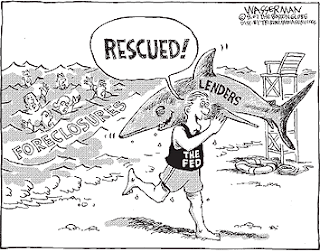I just discovered the Wikipedia Subprime Crisis Impact Timeline that provides a great resource to those trying to understand what this crisis is and how we got here. The timeline spans 40 years from 1968 to the present, including the most recent entry as of this posting: “October 8 [, 2008]: White House considers taking ownership stakes in private banks as a part of the bailout bill. [108] Warren Buffett and George Soros criticized the original approach of the bailout bill.[109][110].”
Notably, the timeline pulls no punches regarding the many causes of this meltdown. It begins, appropriately, with the conversion of Fannie Mae from a government entity to a stand-alone GSE in 1968 (to purchase and securitize mortgages to facilitate liquidity in the primary mortgage market) and the creation of GSE Freddie Mac in 1970 (to buy mortgages on the secondary market, pool them, and sell them as mortgage-backed securities to investors on the open market). While I agree that Freddie and Fannie played no small role in fomenting the atmosphere that eventually led to this crisis, the choice to begin the timeline here seems to place the blame squarely at the feet of the GSEs.
But, the GSEs are not the only quasi-federal entities called out in this fascinating summary. In one of my favorite entries, Wikipedia cites an article from Barron’s Magazine for the following entry: “2003-2007: The Federal Reserve failed to use its supervisory and regulatory authority over banks, mortgage underwriters and other lenders, who abandoned loan standards (employment history, income, down payments, credit rating, assets, property loan-to-value ratio and debt-servicing ability), emphasizing instead lender’s ability to securitize and repackage subprime loans.[22]”
Then, there’s this entry from October 15-17, 2007: “Both Fed chairman Ben Bernanke and Treasury Secretary Hank Paulson expressed alarm about the dangers posed by the bursting housing bubble; Paulson said ‘the housing decline is still unfolding and I view it as the most significant risk to our economy. … The longer housing prices remain stagnant or fall, the greater the penalty to our future economic growth.’[40]” This statement is remarkable in hindsight, as the Fed and Treasury failed to take any significant action to alleviate this crisis until September 2008, when they took over Freddie and Fannie and proposed the “Emergency Economic Stabilization Act.” Of course, this did not prevent Paulson from saying that the proposal was “an urgent matter, and we need to move quickly” as he called for the immediate passage of the largest government bailout since the Great Depression.
Check out Wikipedia’s subprime crisis timeline as this shakeout unfolds for some interesting perspective on the regulatory and legislative missteps that brought us to this point.





